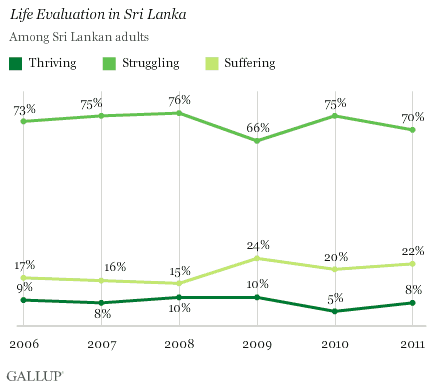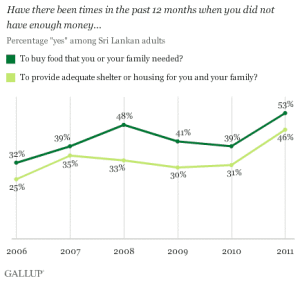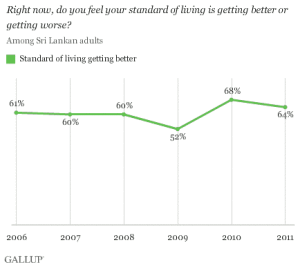
Gallup classifies respondents as “thriving,” “struggling,” or “suffering” according to how they rate their current and future lives on a ladder scale with steps numbered from 0 to 10 based on the Cantril Self-Anchoring Striving Scale. People are considered thriving if they rate their current lives a 7 or higher and expectations for their lives in five years an 8 or higher. People who rate their current or future lives a 4 or lower are classified as suffering. All others are considered struggling.
Suffering percentages worldwide have ranged from as low as 1% to as high as 40% in recent years. The one in five or more Sri Lankans who are suffering falls roughly in the middle, and is similar to the levels that Gallup finds in many developing countries.
In the three years since fighting between the Sri Lankan government and the Liberation Tigers of Tamil Eelam officially ceased, Sri Lanka’s economy posted consecutive years of 8% GDP growth. These improvements came only after Sri Lanka received a loan of more than $2 billion from the International Monetary Fund to avoid further effects from the global financial crisis. But the percentage of the population that is suffering indicates that not all Sri Lankans are reaping the benefits of the country’s recent economic growth.
In fact, more Sri Lankans than ever before are struggling to afford the basics. A majority of Sri Lankans (53%) said in 2011 that there were times in the past 12 months when they did not have enough money to buy food that they or their families needed, and nearly as many (46%) said they struggled to afford adequate shelter. These are the highest percentages Gallup has measured in the country since 2006 and they rival those in Afghanistan — 45% of Afghans said they lacked necessary money for food in the past year, 52% said the same about adequate shelter — as the highest in the region.

Sri Lankans are hopeful, however, that their standard of living is improving. About two-thirds of Sri Lankans in 2011 and 2010 said their standard of living was getting better, significantly higher than the slim majority who said so in 2009.

Bottom Line
The significant percentages of Sri Lankans who were suffering and struggling to afford the food or shelter they needed in the past year reflect the ongoing challenges the country faces in recovering from the economic turmoil in 2008 and 2009. Efforts to improve Sri Lankans’ wellbeing could do a lot to help the country, and its people, move forward. Gallup research finds high wellbeing relates positively to peace, stability, and civic engagement. Additionally, populations with high wellbeing typically experience fewer health problems, less stress and sadness, and more happiness, respect, and enjoyment.
For complete data sets or custom research from the more than 150 countries Gallup continually surveys, please contact [email protected] or call 202.715.3030.
Survey Methods
Results are based on face-to-face interviews with 1,000 adults, aged 15 and older, conducted between 2006 and 2011 in Sri Lanka, and face-to-face interviews with 1,000 adults, aged 15 and older, conducted in 2011 in Afghanistan. For results based on the total sample of national adults, one can say with 95% confidence that the maximum margin of sampling error ranged from ±3.3 percentage points to ±4.1 percentage points. In addition to sampling error, question wording and practical difficulties in conducting surveys can introduce error or bias into the findings of public opinion polls.
For more complete methodology and specific survey dates, please review Gallup’s Country Data Set details.
gallup